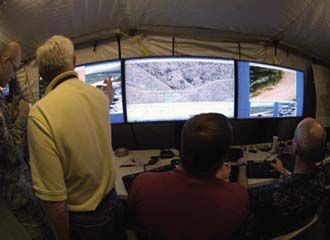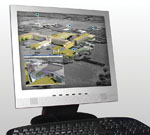Processing Goes Portable
 |
Cmdr. Donald Lee, USN (r), and other Empire Challenge 2010 participants use the Base Expeditionary Targeting and Surveillance System–Combined to search for suspicious activity on the range during Empire Challenge 2010. The annual intelligence, surveillance and reconnaissance demonstration examines emerging capabilities. |
Intelligence analysts are drowning in data, so companies are working to develop life-saving solutions in the areas of processing, compression and visualization. Years of developing titanic numbers of sensors have resulted in an ocean of data that harbors only a few lifeboats. Companies that succeed in these endeavors not only will enhance homeland security but also will reap the benefit of financial windfalls. In addition to having search agents that would help analysts uncover truly useful information, the intelligence community would benefit from new ways to store and move petabytes of data.
Christopher B. Jackson, deputy chief, intelligence, surveillance and reconnaissance (ISR) integration division, Joint Intelligence Operations Center (JIOC), U.S. Joint Forces Command, (JFCOM),
In the area of processing, exploitation and dissemination (PED), the challenge is to develop a way to turn processed data into information and then get it to the analyst. This problem is tied not only to processing speed but also to data management. “We can collect a lot of intelligence, but where are the gold nuggets?”
A second challenge caused by overwhelming amounts of intelligence data involves the bandwidth required to deliver and share it. “You can collect more than you can move around. At a certain point, bandwidth is saturated, and things start dropping off the table,”
A third challenge involves the analysis piece, an area in which improved visualization technologies can assist. Because ISR sensors gather a variety of types of intelligence, this data must be correlated and displayed so that analysts can identify both pockets of information and the relationship between these pockets. Data must be rectified for both geographic locations and time periods so that connections between pieces of data can be ascertained quickly, then provided to commanders at nearly the speed of light.
One additional requirement is the ability to direct sensor processing dynamically so that when needs change, the data the sensors are sending is what is needed at the time. This would require that more than one rule set be put into place so that, as mission requirements change, commanders can access different information from the same sensors,
These challenges are magnified by the desire and need for cross-domain sharing. In operations that involve coalition partners, it is imperative that troops from different nations share information.
Cross-domain sharing was one of several intelligence topics examined at Empire Challenge 2010 (EC10), an annual demonstration that focuses on placing information into warfighters’ hands.
Just as critical to sharing information during missions is the second focus area. It involves both the DCGS and the Global Command and Control System, or GCCS, and determining how to enable the latter to pull information from the former to enhance battlefield awareness. According to
The third area examined during EC10 concentrated on information assurance, a topic that must be a larger part of intelligence sharing,
 |
Featuring full-motion video, TerraSight video exploitation systems and software provides situational awareness, targeting and image analysis forensics using full-motion video. |
Various companies have been developing technologies that address many of these challenges. For example, Sarnoff Corporation,
According to Mike Piacentino, technical director of vision systems at Sarnoff, his company has developed one possible answer to this problem. Generally, sensors collect all available data and send it to the groundstation or one central location for processing and dissemination. Instead, Sarnoff’s Acadia II conducts what the company calls “smart processing.” The processing occurs on the chip. As a result, the amount of bandwidth needed to send information to commanders is reduced significantly.
For example, Piacentino says, the system on a chip can be preprogrammed to search automatically for specific “hot topics” that were designated by the commander on the platform sensor. “Or, the system on a chip can allow operators to say, ‘This is what I want. Send all this information to the ground,’ then they can see and choose what they want. This is a paradigm shift—for the soldier to see what’s over the next hill and for the commander to have a full picture,” he explains.
Another alternative to timely data processing is the company’s solution called Terrasight, which enables control processing from the base station where the commander can prioritize information and send different data to different people in different ways, he adds. This product enables sensor information from the air and ground to be incorporated into a common operational picture in real time. Currently, the U.S. Army has a servicewide license for the TerraSight product.
Piacentino emphasizes the value of products such as Acadia II in solving and addressing the bandwidth challenge. First, the size of the system allows for more sensors to be placed on a platform such as an unmanned aerial vehicle. Second, because processing takes place on a platform prior to downloading the information to the groundstation, the amount of information going through the pipes is only the data the commander requested.
The technology incorporated into Acadia II allows for multifunctional capabilities, he explains. It was originally designed for the Defense Advanced Research Projects Agency for use in its night-vision technology, which is incorporated into helmets, unmanned robots and rifle sights. It operates on 2 watts of power.
Jon Bradburn, senior director of business development at Sarnoff, points out that employing products such as Acadia II improves troops’ protection by providing “a sense of the environment and giving them the opportunity to buy time.”
Bradburn explains that when
Complicating this issue is the international flavor of the forces in theater.
Despite solutions such as Acadia II,
Focusing on these areas was another part of EC10. During the demonstration, the command and control structure included Finnish officers serving in an analog environment similar to that of the International Security Assistance Force structure in
Once the technical aspects of this communications issue can be resolved to the satisfaction of the technical and concept developers, the information will be passed on to those in charge of developing policies, who will determine the best way to ensure that information can be shared with NATO countries as well as with other coalition partners.
Although
This said,
One additional challenge is to be able to change the focus of data-gathering sensors in order to support different missions. “You have to keep in mind that mission sets change not only day to day or hour to hour, but sometimes minute to minute—that’s a tough challenge,” he explains.
WEB RESOURCES
Empire Challenge 2010: www.jfcom.mil/about/fact_ec10.html
Sarnoff Corporation: www.sarnoff.com


Comments